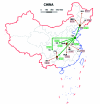The origin and dispersal of the domesticated Chinese oak silkworm, Antheraea pernyi, in China: a reconstruction based on ancient texts
- PMID: 21062145
- PMCID: PMC3016963
- DOI: 10.1673/031.010.14140
The origin and dispersal of the domesticated Chinese oak silkworm, Antheraea pernyi, in China: a reconstruction based on ancient texts
Abstract
Sericulture is one of the great inventions of the ancient Chinese. Besides the mulberry silkworm (Bombyx mori), Chinese farmers developed rearing of the Chinese oak silkworm (Antheraea pernyi) about 400 years ago. In this paper, the historic records of the origins and dispersal of the domesticated Chinese oak silkworm in China are summarized. The first document with clearly recorded oak silkworm artificial rearing appeared in 1651, although Chinese oak silkworm was documented in about 270 AD. All of the evidence in the available historic records suggests that the domesticated Chinese oak silkworm originated in central and southern areas of Shandong Province in China around the 16th century, and then was introduced directly and indirectly by human commerce into the present habitations in China after the late 17th century. The results strongly support the hypothesis that only one geographically distinct event occurred in domestication of the modern Chinese oak silkworm.
Figures

Similar articles
-
Antheraea pernyi (Lepidoptera: Saturniidae) and Its Importance in Sericulture, Food Consumption, and Traditional Chinese Medicine.J Econ Entomol. 2017 Aug 1;110(4):1404-1411. doi: 10.1093/jee/tox140. J Econ Entomol. 2017. PMID: 28535207 Review.
-
Mechanical properties and structure of silkworm cocoons: a comparative study of Bombyx mori, Antheraea assamensis, Antheraea pernyi and Antheraea mylitta silkworm cocoons.Mater Sci Eng C Mater Biol Appl. 2013 Aug 1;33(6):3206-13. doi: 10.1016/j.msec.2013.03.051. Epub 2013 Apr 6. Mater Sci Eng C Mater Biol Appl. 2013. PMID: 23706202
-
cDNA cloning and expression pattern of two enolase genes from the Chinese oak silkworm, Antheraea pernyi.Acta Biochim Biophys Sin (Shanghai). 2010 Nov;42(11):816-26. doi: 10.1093/abbs/gmq084. Epub 2010 Oct 5. Acta Biochim Biophys Sin (Shanghai). 2010. PMID: 20923858
-
Preferential codon usage and two types of repetitive motifs in the fibroin gene of the Chinese oak silkworm, Antheraea pernyi.Insect Mol Biol. 1997 Feb;6(1):89-95. doi: 10.1046/j.1365-2583.1997.00161.x. Insect Mol Biol. 1997. PMID: 9013260
-
Chinese Oak Tasar Silkworm Antheraea pernyi Silk Proteins: Current Strategies and Future Perspectives for Biomedical Applications.Macromol Biosci. 2019 Mar;19(3):e1800252. doi: 10.1002/mabi.201800252. Epub 2018 Oct 8. Macromol Biosci. 2019. PMID: 30294916 Review.
Cited by
-
Morphological characterization and HSP70-, IGS-based phylogenetic analysis of two microsporidian parasites isolated from Antheraea pernyi.Parasitol Res. 2017 Mar;116(3):971-977. doi: 10.1007/s00436-017-5373-6. Epub 2017 Jan 22. Parasitol Res. 2017. PMID: 28111712
-
Between semelparity and iteroparity: Empirical evidence for a continuum of modes of parity.Ecol Evol. 2017 Sep 7;7(20):8232-8261. doi: 10.1002/ece3.3341. eCollection 2017 Oct. Ecol Evol. 2017. PMID: 29075446 Free PMC article. Review.
-
Larval crowding effects during early development in the Chinese oak silkmoth Antheraea pernyi (Lepidoptera: Saturniidae).Ecol Evol. 2022 Sep 11;12(9):e9283. doi: 10.1002/ece3.9283. eCollection 2022 Sep. Ecol Evol. 2022. PMID: 36110887 Free PMC article.
-
Molecular characterization and phylogenetic analysis of the eukaryotic translation initiation factor 4A gene in Antheraea pernyi (Lepdoptera: Saturniidae).J Insect Sci. 2014 Jan 1;14:168. doi: 10.1093/jisesa/ieu030. Print 2014. J Insect Sci. 2014. PMID: 25480968 Free PMC article.
-
Degumming and characterization of Bombyx mori and non-mulberry silks from Saturniidae silkworms.Sci Rep. 2023 Nov 9;13(1):19504. doi: 10.1038/s41598-023-46474-5. Sci Rep. 2023. PMID: 37945634 Free PMC article.
References
-
- Chang DC, McWatters HG, Williams JA, Gotter AL, Levine JD, Reppert SM. Constructing a feedback loop with circadian clock molecules from the silkmoth, Antheraea pernyi. Journal of Biological Chemistry. 2003;278(40):38149–38158. - PubMed
-
- Chen DS. The production and dispersal of oak silkworm in Shandong Province during Qing Dynasty. Ancient and Modern Agriculture. 1994;(1):11–17. 10, in Chinese.
-
- Chou I. A history of Chinese entomology. Entomotaxonomia, Wugong: Chinese with English summary; 1980. p. 213.
-
- Goldsmith MR, Shimada T, Abe H. The genetics and genomics of the silkworm, Bombyx mori. Annual Review of Entomology. 2004;50:71–100. - PubMed
-
- Gu KB. Review of phylogeny on tussah sericulture. Agricultural Archaeology. 1995;3:206–214. in Chinese.
Publication types
MeSH terms
Substances
LinkOut - more resources
Full Text Sources
Medical

